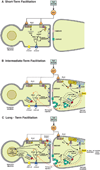New tricks for an old slug: the critical role of postsynaptic mechanisms in learning and memory in Aplysia
- PMID: 18394481
- PMCID: PMC2855241
- DOI: 10.1016/S0079-6123(07)00017-9
New tricks for an old slug: the critical role of postsynaptic mechanisms in learning and memory in Aplysia
Abstract
The marine snail Aplysia has served for more than four decades as an important model system for neurobiological analyses of learning and memory. Until recently, it has been believed that learning and memory in Aplysia were due predominately, if not exclusively, to presynaptic mechanisms. For example, two nonassociative forms of learning exhibited by Aplysia, sensitization and dishabituation of its defensive withdrawal reflex, have been previously ascribed to presynaptic facilitation of the connections between sensory and motor neurons that mediate the reflex. Recent evidence, however, indicates that postsynaptic mechanisms play a far more important role in learning and memory in Aplysia than formerly appreciated. In particular, dishabituation and sensitization depend on a rise in intracellular Ca(2+) in the postsynaptic motor neuron, postsynaptic exocytosis, and modulation of the functional expression of postsynaptic AMPA-type glutamate receptors. In addition, the expression of the persistent presynaptic changes that occur during intermediate- and long-term dishabituation and sensitization appears to require retrograde signals that are triggered by elevated postsynaptic Ca(2+). The model for learning-related synaptic plasticity proposed here for Aplysia is similar to current mammalian models. This similarity suggests that the cellular mechanisms of learning and memory have been highly conserved during evolution.
Figures


Similar articles
-
Synaptic facilitation and behavioral dishabituation in Aplysia: dependence on release of Ca2+ from postsynaptic intracellular stores, postsynaptic exocytosis, and modulation of postsynaptic AMPA receptor efficacy.J Neurosci. 2005 Jun 8;25(23):5623-37. doi: 10.1523/JNEUROSCI.5305-04.2005. J Neurosci. 2005. PMID: 15944390 Free PMC article.
-
The role of rapid, local, postsynaptic protein synthesis in learning-related synaptic facilitation in aplysia.Curr Biol. 2007 Dec 4;17(23):2073-80. doi: 10.1016/j.cub.2007.10.053. Epub 2007 Nov 20. Curr Biol. 2007. PMID: 18006316 Free PMC article.
-
Presynaptic and postsynaptic mechanisms of synaptic plasticity and metaplasticity during intermediate-term memory formation in Aplysia.J Neurosci. 2010 Apr 21;30(16):5781-91. doi: 10.1523/JNEUROSCI.4947-09.2010. J Neurosci. 2010. PMID: 20410130 Free PMC article.
-
The cellular mechanisms of learning in Aplysia: of blind men and elephants.Biol Bull. 2006 Jun;210(3):271-9. doi: 10.2307/4134563. Biol Bull. 2006. PMID: 16801500 Review.
-
Learning in Aplysia: looking at synaptic plasticity from both sides.Trends Neurosci. 2003 Dec;26(12):662-70. doi: 10.1016/j.tins.2003.09.014. Trends Neurosci. 2003. PMID: 14624850 Review.
Cited by
-
Fear conditioning in invertebrates.Front Behav Neurosci. 2022 Nov 10;16:1008818. doi: 10.3389/fnbeh.2022.1008818. eCollection 2022. Front Behav Neurosci. 2022. PMID: 36439964 Free PMC article. Review.
-
The participation of NMDA receptors, PKC, and MAPK in the formation of memory following operant conditioning in Lymnaea.Mol Brain. 2010 Aug 31;3:24. doi: 10.1186/1756-6606-3-24. Mol Brain. 2010. PMID: 20807415 Free PMC article.
-
Description and validation of a dynamical systems model of presynaptic serotonin function: genetic variation, brain activation and impulsivity.Behav Genet. 2010 Mar;40(2):262-79. doi: 10.1007/s10519-010-9335-3. Epub 2010 Jan 29. Behav Genet. 2010. PMID: 20111992 Free PMC article.
-
Repeated stimulation of feeding mechanoafferents in Aplysia generates responses consistent with the release of food.Learn Mem. 2024 Jul 1;31(6):a053880. doi: 10.1101/lm.053880.123. Print 2024 Jun. Learn Mem. 2024. PMID: 38950976 Free PMC article.
-
Susceptibility of memory consolidation during lapses in recall.Nat Commun. 2013;4:1578. doi: 10.1038/ncomms2591. Nat Commun. 2013. PMID: 23481386 Free PMC article.
References
-
- Abrams TW, Castellucci VF, Camardo JS, Kandel ER, Lloyd PE. Two endogenous neuropeptides modulate the gill and siphon withdrawal reflex in Aplysia by presynaptic facilitation involving cAMP-dependent closure of a serotonin-sensitive potassium channel. Proc. Natl. Acad. Sci. USA. 1984;81:7956–7960. - PMC - PubMed
-
- Alarcon JM, Malleret G, Touzani K, Vronskaya S, Ishii S, Kandel ER, Barco A. Chromatin acetylation, memory, and LTP are impaired in CBP+/− mice: a model for the cognitive deficit in Rubinstein-Taybi syndrome and its amelioration. Neuron. 2004;42:947–959. - PubMed
-
- Alberini CM, Ghirardi M, Metz R, Kandel ER. C/EBP is an immediate-early gene required for the consolidation of long-term facilitation in Aplysia. Cell. 1994;76:1099–1114. - PubMed
Publication types
MeSH terms
Substances
Grants and funding
LinkOut - more resources
Full Text Sources
Medical
Research Materials
Miscellaneous

